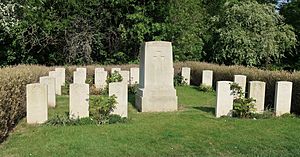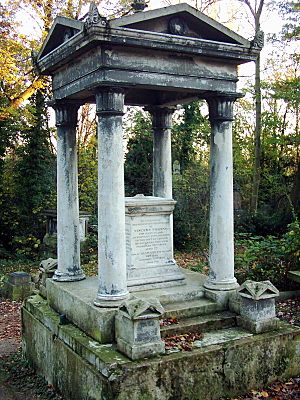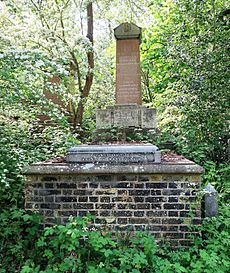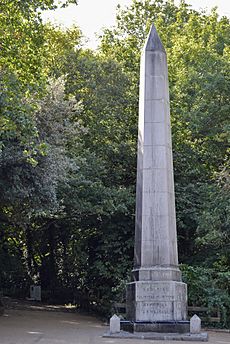Nunhead Cemetery facts for kids

View up The Avenue from the North Gate towards the Anglican Chapel
|
|
| Details | |
|---|---|
| Established | 1840 |
| Location |
London, SE15
|
| Country | England |
| Type | Public |
| Size | 21 hectares (52 acres) |
| No. of graves | ? |
| No. of interments | ? |
Nunhead Cemetery is a famous old cemetery in London, England. It is one of the "Magnificent Seven" cemeteries built around London a long time ago. You can find it in an area called Nunhead in the London Borough of Southwark. When it first opened, it was known as All Saints' Cemetery.
Nunhead Cemetery was officially opened in 1840 by the London Cemetery Company. Today, it's not just a cemetery; it's also a special Local Nature Reserve. This means it's a protected area for wildlife and plants.
Contents
Where is Nunhead Cemetery?
The main entrance, called the North Gate, is on Linden Grove. It's close to Daniel's Road. There's also a South Gate on Limesford Road. The cemetery is located in the London Borough of Southwark, which is in southeast London.
A Look at History and Nature
How it Started
Nunhead Cemetery was opened in 1840. It has an Anglican chapel that was designed by an architect named Thomas Little. This cemetery is one of the "Magnificent Seven" Victorian cemeteries. These were large cemeteries built around London in the 1800s. They were needed because the city's churchyards were getting too full.
The very first person buried here was Charles Abbott, who was 101 years old. The cemetery was used for many years.
From Cemetery to Nature Reserve
By the middle of the 1900s, the cemetery was almost full. The company that owned it stopped taking care of it. Because of this, the cemetery slowly changed. The lawns became meadows, and then it turned into a woodland.
Today, Nunhead Cemetery is a Local Nature Reserve. It's also an important place for wildlife in London. You can find many songbirds, woodpeckers, and tawny owls living there.
Bringing it Back to Life
For a while, the graves were damaged by nature and even by people. But in the early 1980s, a group called the Friends of Nunhead Cemetery was formed. They wanted to fix up and protect the cemetery.
Thanks to their hard work and money from Southwark Council and the Heritage Lottery Fund, the cemetery was reopened in May 2001. Many memorials were fixed, and the Anglican Chapel was also restored.
Famous People Buried Here
Nunhead Cemetery is the final resting place for many interesting people. Here are a few of them:
- Sir Frederick Abel (1827–1902): He helped invent Cordite, a type of gunpowder.
- Robert Abel (1857–1936): A famous English cricket player.
- Bryan Donkin (1768–1855): An engineer who helped create machines for making paper and for canning food.
- Vincent Figgins (1766–1844): A person who designed and made printing types.
- Sir Charles Fox (1810–1874): A civil and railway engineer.
- Jenny Hill (1848–1896): A popular music hall performer.
- Sir George Livesey (1834–1908): An engineer and a kind person who helped others.
- Thomas Tilling (1825–1893): A very successful bus company owner.
Layout and Special Monuments
Nunhead Cemetery is quite large, covering about 52 acres. It's the second biggest of the Magnificent Seven cemeteries. From some parts of the cemetery, you can even see St Paul's Cathedral in the distance!
Exploring the Cemetery
The older parts of the cemetery are like a beautiful wild forest. Many locals call it a nature reserve. You might see vines growing over some areas, and some old gravestones lean to the side. The Friends of Nunhead Cemetery are working hard to restore it, but it still needs a lot of care. It's a popular spot for walks.
Important Memorials
- Scottish Political Martyrs Memorial: This is a tall stone monument called an obelisk. It remembers the leaders of a group called the Friends of the People Society, also known as the Scottish Martyrs. They were sent to Australia in 1794 for their political beliefs. This memorial was put up in 1837.
- Sea Scouts Memorial: This memorial remembers nine young Sea Scouts who sadly died in a boating accident in 1912. One of them was Percy Baden Powell Huxford, who was only 12 years old. The original memorial was damaged, but a new one was put up in 1992.

War Graves
Nunhead Cemetery has many graves for soldiers who died in the First World War and Second World War. Most of these are from the First World War. There are special areas for soldiers from the United Kingdom, Australia, and Canada. There's also a Belgian war grave from the First World War.
Guided Tours
If you want to learn more, the Friends of Nunhead Cemetery offer guided tours. They happen on the last Sunday of each month, starting from the Linden Grove gates at 2:15 p.m. In the middle of the cemetery, you can see the remains of the Anglican Chapel. Its roof is gone, but its stone walls are still standing.
Nunhead Cemetery in Books and Movies
This cemetery has appeared in different forms of media:
- Poems: It's the setting for a poem called In Nunhead Cemetery by Charlotte Mew. It's also mentioned in Maurice Riordan's poem The January Birds.
- Novels: A science fiction book called The Woman Between the Worlds by F. Gwynplaine MacIntyre features a burial at Nunhead Cemetery.
- TV Shows and Movies:
* It was used in an episode of the BBC series Spooks in 2008. * Scenes from the 1971 movie Melody were filmed here. * An episode of London's Burning in 1995 also featured the cemetery.
Gallery
Nunhead Cemetery is one of the Magnificent Seven cemeteries. It is one of the two cemeteries located south of the river Thames (the other being West Norwood Cemetery).
-
The view of St Paul's Cathedral from the upper part of the Cemetery
Getting There
It's easy to reach Nunhead Cemetery using public transport:
- Bus: Routes 78, 343, and 484 all have stops nearby.
- Train: Nunhead railway station is very close to the cemetery.














